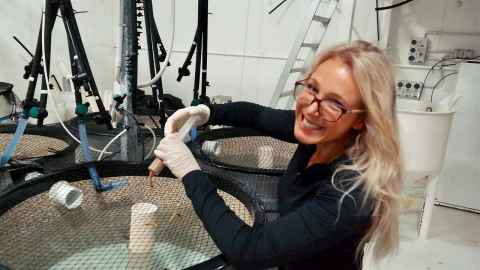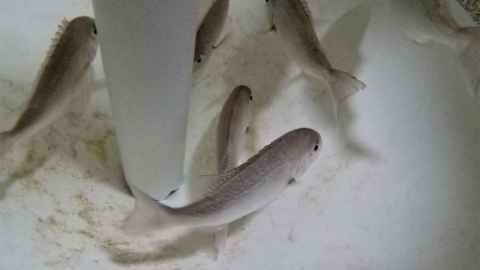Fish snack on microplastics
22 October 2019
Microplastics are being fed to snapper, New Zealand’s most popular recreational fish species, in a bid to establish baseline data about how fish are being affected.

Marine science student Veronica Rotman, working at NIWA’s aquaculture research facility near Whangarei under the supervision of NIWA fisheries scientist and marine science senior lecturer Dr Darren Parsons, is undertaking a two-part experiment to understand how one of the world’s most pervasive pollutants is affecting fish in New Zealand waters.
Ms Rotman says little research has been done in this area and she saw an opportunity to undertake some work that was relevant to New Zealand.
“It’s critical to find out what’s going on with plastic in our ecosystems – I want to see whether the plastic is ejested, remains in the gut or migrates to other parts of the fish, including the flesh we eat.”
Using coloured polystyrene – one of the ocean’s top five plastic polluters - and a blender to generate microplastics between 50 microns and 2mm in size, Ms Rotman soaked samples in the Waitemata Harbour for just over a month to mimic similar conditions fish experience in the environment.
“Plastic acts as a sponge for pollutants, soaking up harbour waste - industrial chemicals, pesticides, heavy metals and bacteria, so I wanted a relevant environmental treatment.”

The polystyrene is then fed in varying amounts to 160 juvenile snapper, along with their regular diet, to snapper held in 20 aquaculture tanks at NIWA’s Northland Marine Research Centre at Bream Bay.
After 10 weeks of treatment the snapper will be dissected to determine how much plastic the fish have retained, any effects on growth or condition, whether it has done any damage to their gastrointestinal tract and whether the microplastics translocated into the liver and muscular tissue.
“What I’m really interested in is the levels of toxicity caused by microplastics accumulating in the digestive tract. The snapper experiment should shed some light on whether microplastics can translocate into the flesh we eat and how exposure may impact snapper physiology, reproduction and fitness.”
The second part of the experiment will see the focus shift to hoki – New Zealand’s most commercially valuable finfish species. Hoki are a deep-sea fish and Ms Rotman will examine specimens from Cook Strait, the West Coast and the Chatham Rise to investigate the gut of the fish to discover whether they fish are ingesting plastic.
“It will be very interesting to see whether hoki are consuming microplastics and if there are any variations between the different sample locations due to proximity to human settlement and sources of pollution."
This work will contribute to Ms Rotman’s Masters thesis and she is intending to submit a paper on the results to a scientific journal for publication.
Media contact
Anne Beston | Media adviser
DDI 09 923 3258
Mob 021 970 089
Email a.beston@auckland.ac.nz